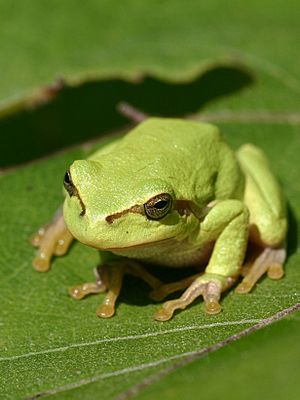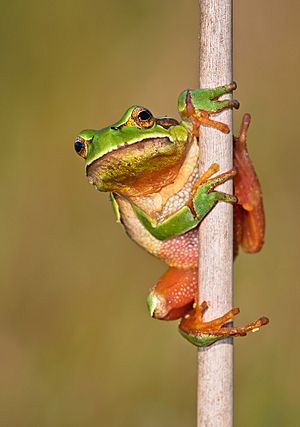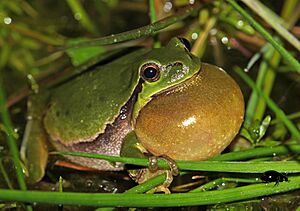Hyla facts for kids
Quick facts for kids Hyla |
|
|---|---|
 |
|
| European tree frog, Hyla arborea | |
| Scientific classification |
|
| Kingdom: | Animalia |
| Phylum: | Chordata |
| Class: | Amphibia |
| Order: | Anura |
| Family: | Hylidae |
| Subfamily: | Hylinae |
| Genus: | Hyla Laurenti, 1768 |
| Species | |
|
See text |
|
Hyla is a group of tree frogs. They belong to the family Hylidae.
For many years, scientists have studied these frogs. They sometimes change their minds about which frogs belong in the Hyla group. They also decide which frogs should be in other groups like Litoria or Ranoidea.
Long ago, the Hyla group had over 300 different kinds of frogs. These frogs lived in Europe, Asia, Africa, and all over the Americas. Today, the Hyla group has only 17 living species. These species are found in Europe, northern Africa, and Asia.
The oldest known fossil of a Hyla frog is called †Hyla swanstoni. It was found in Saskatchewan, Canada. This fossil is from the Eocene time period.
A scientist named Josephus Nicolaus Laurenti created the Hyla group in 1768. He named it after Hylas. Hylas was a friend of Hercules in Greek mythology. Even though Hylas was a male, the name Hyla is treated as a feminine word in grammar.
Some people think the name comes from a Greek word meaning "forest." But this is not true.
Contents
Living Species of Hyla
There are 17 known living species in the Hyla group. Here are some of them:
| Scientific Name | Common Name |
|---|---|
| H. annectans (Jerdon, 1870) | Jerdon's tree frog |
| H. arborea (Linnaeus, 1758) | European tree frog |
| H. carthaginiensis Dufresnes, Beddek, Skorinov, Fumagalli, Perrin, Crochet, and Litvinchuk, 2019 | Carthaginian tree frog |
| H. chinensis Günther, 1858 | Common Chinese tree frog |
| H. felixarabica Gvoždík, Moravec, Klütsch & Kotlík, 2010 | Arabian tree frog |
| H. hallowellii Thompson, 1912 | Hallowell's tree frog |
| H. intermedia Boulenger, 1882 | Italian tree frog |
| H. meridionalis Boettger, 1874 | Mediterranean tree frog |
| H. molleri Bedriaga, 1889 | Moller's tree frog |
| H. orientalis Bedriaga, 1890 | Oriental tree frog |
| H. perrini Dufresnes, Mazepa, Rodrigues, Brelsford, Litvinchuk, Sermier, Lavanchy, Betto-Colliard, Blaser, Borzée, Cavoto, Fabre, Ghali, Grossen, Horn, Leuenberger, Phillips, Saunders, Savary, Maddalena, Stöck, Dubey, Canestrelli, and Jeffries, 2018 | Perrin's tree frog |
| H. sanchiangensis Pope, 1929 | San Chiang tree frog |
| H. sarda (De Betta, 1853) | Sardinian tree frog |
| H. savignyi Audouin, 1827 | Middle East tree frog |
| H. simplex Boettger, 1901 | Annam tree frog |
| H. tsinlingensis Liu and Hu in Hu, Zhao, and Liu, 1966 | Shensi tree frog |
| H. zhaopingensis Tang and Zhang, 1984 | Zhaoping tree frog |
Reproduction and Mating
Hyla frogs have interesting ways of finding mates.
Female Frogs Choose Mates
In most Hyla species, male frogs sing to attract females. The female frogs then listen to these songs. They choose a male based on what they like about his voice.
For example, female H. versicolor frogs like males whose calls last longer. Female H. arborea frogs choose males who sing in the same spot for many nights. This shows the male is strong and reliable.
Male Frogs Compete
Some male Hyla frogs will compete with each other. This is a type of competition to win over females. Male H. versicolor frogs gather in places where females like to go. This gathering behavior is called lekking. It is common in many Hyla species.
To sing clearly, male frogs need to be a certain distance apart. If one male gets too close to another's singing spot, they might fight. Or they might do things that look like fighting. Male H. versicolor sometimes show off to each other first. This helps them see who might win before a real fight starts.
Choosing a Mate Based on Health
Sometimes, one frog chooses a mate based on just one thing. This one thing can show how healthy the mate is overall. This is called indirect selection.
The H. arborea frog is active at night. Female frogs listen to the males sing to choose a mate. These frogs can also see well in dim light. This good eyesight might be linked to how females choose males.
Scientists think female H. arborea choose males with bright, colorful vocal sacs. A colorful vocal sac might mean the male frog eats enough carotenoids. Carotenoids are special nutrients found in food. This could mean the male frog is good at finding food. He might pass this skill on to his baby frogs.
Images for kids
-
European tree frog, Hyla arborea
- Frost, Darrel R. 2007. Amphibian Species of the World: an Online Reference. Version 5.1 (10 October 2007). Hyla. Electronic Database accessible at https://web.archive.org/web/20071024033938/http://research.amnh.org/herpetology/amphibia/index.php. American Museum of Natural History, New York, USA. (Accessed: Apr 21, 2008).
- AmphibiaWeb: Information on amphibian biology and conservation. [web application]. 2008. Berkeley, California: Hyla. AmphibiaWeb, available at http://amphibiaweb.org/. (Accessed: Apr 21, 2008).
- eol - Encyclopedia of Life taxon Hyla at http://www.eol.org.
See also
 In Spanish: Hyla para niños
In Spanish: Hyla para niños






